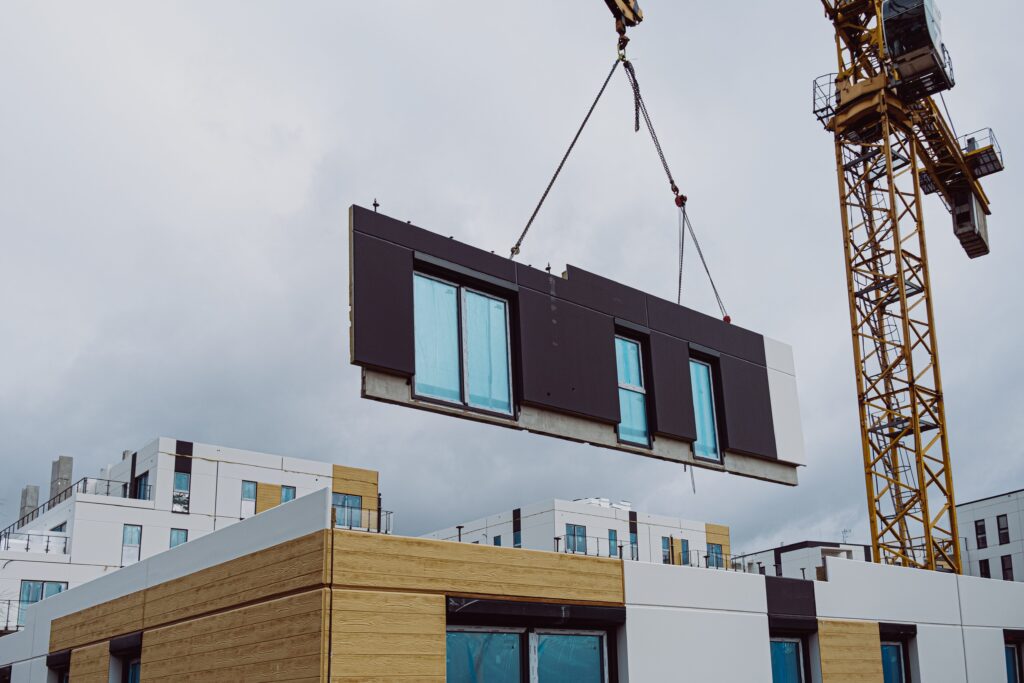Prefab construction is the future – are you ready?
Every year (as aimed for by the government), we will ‘just’ build 300,000 new homes. No problem thanks to: “Digitalisation, standardisation and industrialisation.” While we’re at it, let’s put some other ambitious projects on the wish list as well. And it’s all possible, because we are going to build prefabs. It’s quick as lightning and very easy. Right?
But what is actually meant by prefab construction these days? And what role does digitalisation play in this?

Prefab is not new, but it is modern
Building with prefabricated elements is not new. Those in a hurry can find a picture of a prefab house called ‘AIROH’ on Wikipedia. That is on permanent display in a museum, originally built in 1950. Yet, prefab is currently in a state of flux. This is not surprising. Prefab is a classic construction method that is eminently suitable to be digitally supported. It rightly takes its place among the other big topics: connected construction sites and the digitalisation of cooperation within the supply chain.
Read all about document management here.
Project managers can plan smarter [through prefabs].
Construction project planning and execution with BIM
BIM (Building Information Management) is an example of a system that supports digital construction. Within this model, not only the blueprints are recorded, but also the time needed to carry out the construction is planned. This creates opportunities. Project managers can plan smarter. The crane that has to lay concrete floors for the second floor is not needed until the columns of the first floor are standing (to give just one example). You can estimate that with BIM, and factor it into the planning.
Digitisation of the construction supply chain
Digitisation of the construction chain is about more than BIM alone. It would be nice if all construction combinations, project managers, manufacturers and suppliers could exchange information completely within one standard. But we have to start somewhere. Digitising within your own company is beneficial, as companies that digitise are more likely to see turnover grow, according to the Dutch bank Rabobank. Even if they do not seek wider collaboration within the supply chain.
BIM is a great system to include in new automation projects. However, even if you are not linked up to the supply chain directly, you can reap the benefits of digitalisation within your own organisation.
Not just planning, also executing
Prefabricated construction in the modern sense, is not just about deploying the ready-made building components. It is mainly about how their delivery and installation are administered. An architect can directly use 3D building blocks based on the manufacturer’s specifications in his software. Based on those blueprints, installers plan models of the installations. By bringing that data to the project environment, collaboration and coordination can be better supervised.
The project manager’s project environment is the hub for all generated data.
Planning software
The project manager’s project environment is the hub for all data generated. Plans, work planning, progress reports and budget monitoring come together here. The project manager links performers to sub-tasks, sees problems arising and keeps an eye on manufacturers. One data point related to prefab, is the expected delivery time according to the manufacturer. Based on this, you can plan transport, hire machines, signal work planners and schedule construction workers.
Robots, cobots and 3D printers
If we take this scenario a little further, robots (working independently) and cobots (working together with humans) come into view. Shortage of personnel in construction should eventually be partly overcome with innovation. If you know what prefabricated parts you use, you can see what you could have installed by robots. Where a robot does not suffice, a cobot can help your people. For example, it can hand glue blocks to the builder who places them. You can also start using 3D printers for construction, set excavators based on available measurement data, and so on.
Easily exchange data between systems
When it comes to automation, the cloud offers opportunities to stay in the game, even as a medium-sized or small construction company. This development has made it easier to exchange data between different systems. As a construction company, you don’t have to work with the same software as everyone else. You don’t have to match that multi-million dollar investment from an international conglomerate, as long as your data can be shared flexibly.
Will you help build 300,000 prefab houses a year?
Therein lies an important action point for any ambitious builder. Do you know whether your inventory management, planning and the like are easily shared with third parties? Is the answer ‘no’, or are you not sure? Then it is high time to take a look at this (or have it looked at). If you want to join the construction of 300,000 prefab houses a year, or aspire to join one of the other construction projects in the UK, you need to be ready to collaborate on digitally driven prefab projects.